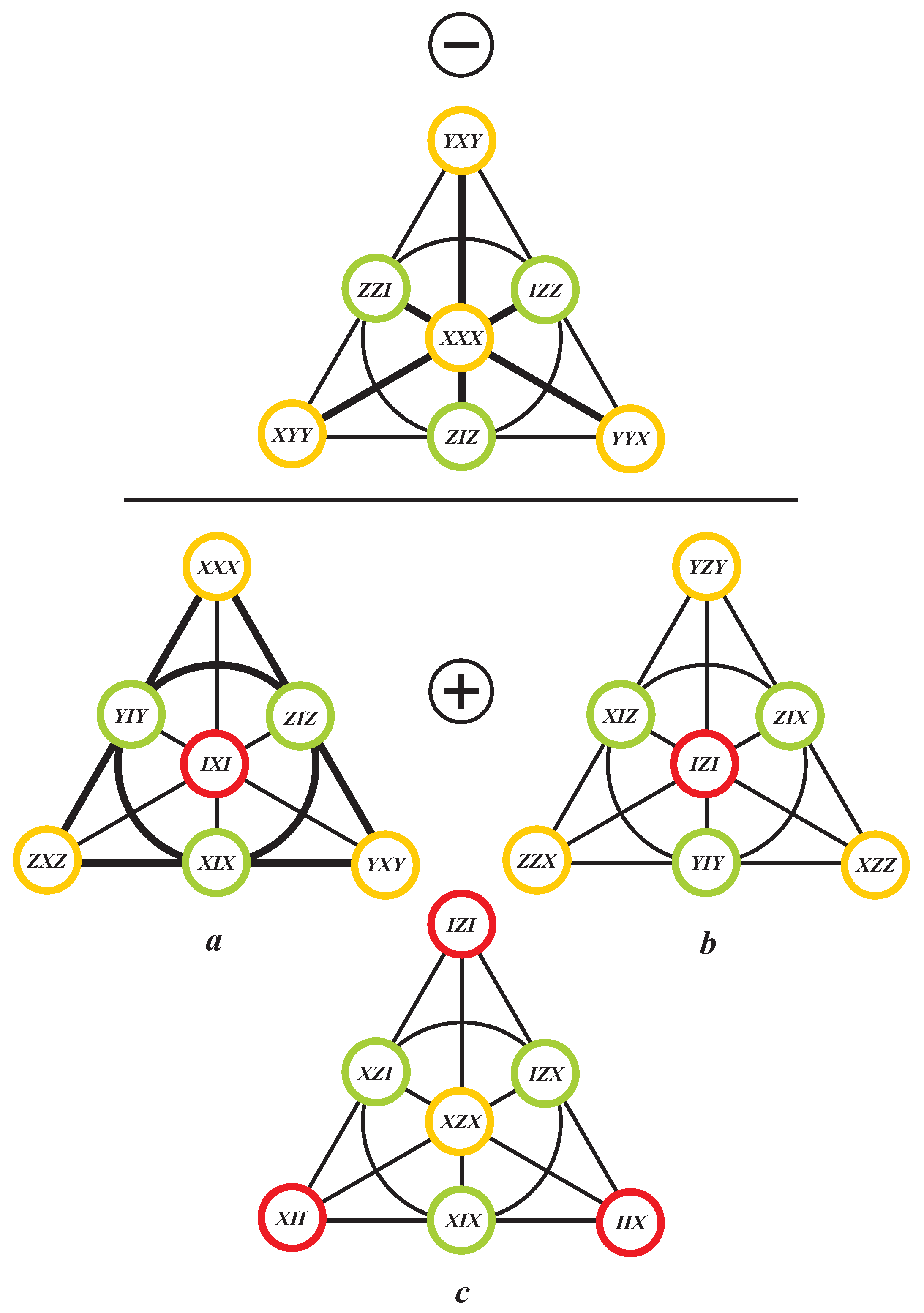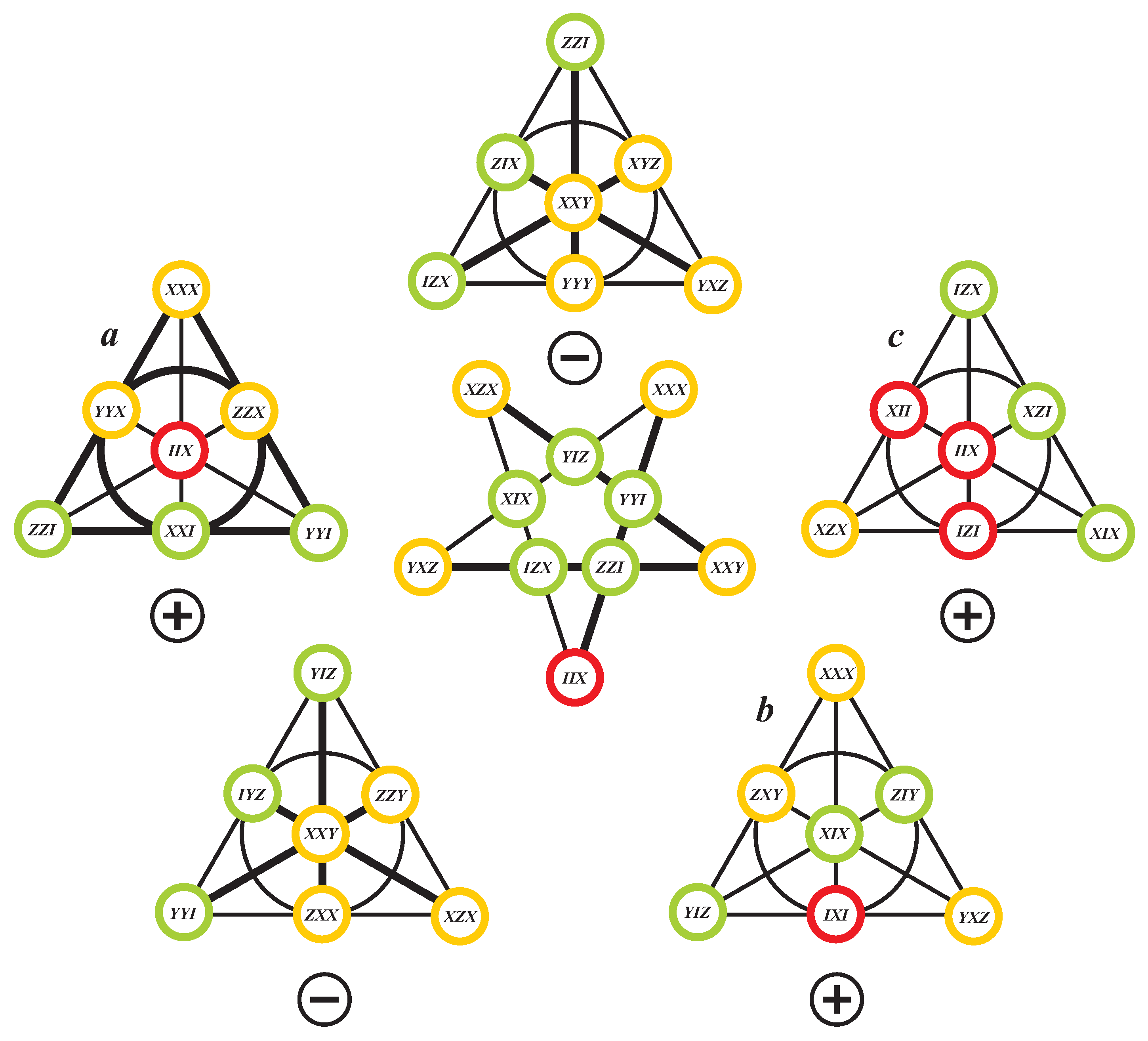2. Finite Symplectic Polar Spaces, Fano Plane, and Generalized Pauli Groups
We shall first introduce some necessary details about the most relevant mathematical notions to be employed. A (finite-dimensional) classical polar space (see, e.g., [
6]) describes the geometry of a
d-dimensional vector space over the Galois field
,
, carrying a non-degenerate reflexive sesquilinear form
. The polar space is called symplectic, and usually denoted as
, if this form is bilinear and alternating, i.e., if
for all
; such a space exists only if
, where
N is called its rank. A subspace of
is called totally isotropic if
vanishes identically on it.
can then be regarded as the space of totally isotropic subspaces of
, the ordinary
-dimensional projective space over
, with respect to a symplectic form. Its maximal totally isotropic subspaces, also called generators, have the dimension
. For
this polar space contains
points and
generators.
contains two different types of non-degenerate quadrics, elliptic and hyperbolic. A hyperbolic quadric is formed by all points of
satisfying the standard equation
; for
this quadric is also called the Klein quadric.
A projective plane consists of two sets, called lines and points, satisfying the following axioms: there exists a unique line incident with any two given points; there exists a unique point incident with any two given lines; and, there are four points of which no three are on the same line. The projective plane of order two, the Fano plane, is the smallest projective plane. It contains seven points and seven lines, with three points on a line and three lines through a point. Each generator of is isomorphic to the Fano plane. When one removes a line from the Fano plane one gets the affine plane of order two.
The (generalized)
N-qubit Pauli group,
, is generated by
N-fold tensor products of the matrices
Most interesting, from the physical point of view, is its factored version
, where the center
consists of
and
, since its properties are intricately linked to the structure of the symplectic polar space
induced by its parent group
. The elements of
are equivalence classes of the form
. For a particular value of
N, the
elements of
can be bijectively identified with the same number of points of
in such a way that two collinear points are represented by two equivalence classes, such that each element of one class commutes with each element of the other class and each maximal set of equivalence classes of pairwise commuting representatives corresponds to a generator of
. The above correspondence was, in a more general context/setting, studied and worked out in Reference [
7] (see also [
8]), where the interested reader is referred to for more details and several (
and
) illustrative examples. In what follows, we shall make use of such bijection for the particular case of
.
3. Three-Qubit Observables and Positive/Negative Fano Planes
To begin with, we consider the following ‘canonical’ representatives (in what follows, we shall use a shorthand notation for the tensor product: ) of the 63 non-trivial elements of
This choice of representatives is essentially dictated by two facts. The first one is that any physically relevant quantity must be an
observable, i.e., a
Hermitian matrix; this requirement thus rules out all representatives with
factors. The second requirement is simplicity in the sense that all 63 representatives should have the same sign; and all the examples of Mermin pentagrams we have found in the literature available make use of the + sign. Let us therefore assume that
has its points labeled by these canonical elements in the way described in
Section 2. If we take a coordinate basis of
in which the symplectic form
is given by
then this labeling acquires the form
with the understanding that
thus, for example, the point of
having coordinates
corresponds to the element
. A line/plane of such a space is then called positive or negative according to the product of the group elements located in it, that is
or
, respectively. Next, let us call a canonical element to be of type
A,
B, or
C in dependence on whether, respectively, it features two
I’s, one
I, or no
I; obviously, there are nine elements of type
A and 27 ones of both type
B and type
C. With this last notion at hand, we will find that there are four different types of three-qubit-labeled Fano planes: one negative type and three positive ones. A negative Fano plane consists of three concurrent negative lines. If a positive Fano plane contains negative lines (type
a), there are always four of them, forming the Pasch configuration. If a positive Fano plane is devoid of negative lines, then it has either one element of type
A and three of type
C (type
b), or vice versa (type
c). The situation is schematically illustrated in
Figure 1. Out of 135 Fano planes of our ‘labeled’
, there are 54 negative and 81 positive ones, the latter being distributed equally into the three types.
4. Taxonomy of Mermin Pentagrams
Given a Mermin pentagram, the first parameter of our classification is the number of negative contexts. The next three parameters are the character of three-qubit elements located on it. For example, the pentagram depicted in
Figure 2 has three negative contexts and features one observable of type
A, five of type
B, and four of type
C. Next, in Reference [
5] it was shown that each edge of a pentagram is isomorphic to an affine plane of order two. As each such plane can uniquely be extended to the projective plane of order two, this also means that each edge is associated with the unique positive- or negative-valued Fano plane. The types of the five associated Fano planes will be the last string of parameters of our classification. Using again the example from
Figure 2, we find here two negative and three positive Fano planes, the latter falling into all three types.
In order to fully classify Mermin pentagrams in this manner, we made use of particular sets of them computed by Michel Planat [
9]. One such set comprises all 336 pentagrams located on a particular Klein quadric and another set consists of those pentagrams located (as point-sets) in a particular geometric hyperplane of a copy of the split Cayley hexagon of order two embedded classically into our three-qubit symplectic polar space [
3]. To check for completeness, we randomly picked up pentagrams from the whole set, for each of them we looked for those ten pentagrams, each of which shares two edges with the pentagram in question and compared their types with those already found. The results of our analysis are summarized in
Table 1; note that our pentagram of
Figure 2 belongs to type 15.
Let us highlight some of the most interesting properties of Mermin pentagrams stemming from our analysis. Obviously, there are only two types where all five Fano planes are negative (types 1 and 4) or positive (types 41 and 42). No pentagram possesses less than two observables of type C, or has just eight of them. If a pentagram features observables of type B, there are four or five of them; and if an edge of such a pentagram contains one such observable, it must contain one more. Next, if a pentagram contains just three observables of type A, they are situated on the same edge; the only exception are types 41 and 42, since they feature no negative Fano plane. There are no pentagrams featuring more than six observables of type A. Any pentagram that contains positive Fano planes of type b and c, but none of type a, is that with a single negative context; the only exception to this rule is type 12. One also sees that a pentagram with no observable of type A is also devoid of positive Fano planes of type c. Further, if a pentagram is associated with Fano planes featuring all the three positive types, then this pentagram also exhibits all the three kinds of observables, with a single exception (type 19). It is also worth mentioning that there are three types of pentagrams having positive Fano planes of type c only (types 13, 27, and 45), as well as two types with all positive Fano types being equally represented (types 15 and 32). From the physical point of view, the most important finding is certainly the existence of two different types of negative contexts of Mermin pentagrams and as many as four distinct kinds of positive ones; the former case involves negative Fano planes and positive Fano planes of type a, whereas the latter one entails all the four types of valued Fano planes. A particularly nice example of these properties is furnished by a pentagram of types 28 or 36, whose single negative context is associated with a positive Fano plane and the remaining four positive contexts are all of different characters.
As a particular task, we also analyzed case by case all 336 pentagrams lying on that hyperbolic quadric (Klein quadric) of
that accommodates all 35 symmetric canonical elements (i.e., elements featuring two or zero
Y’s), and found out that they only fall into 33 distinct types; interestingly enough, the twelve missing types are types 2, 3, 4, 6, 8, 9, 11, 14, 17, 21, 25, and 31, none of them being associated with a positive Fano plane of type
c (see the last column of
Table 1).







